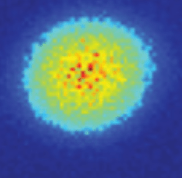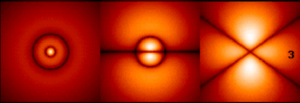In the early 1900’s, when physicists were first probing the insides of the atom, they thought that electrons might travel around the nucleus of the atom in an orbit. This is the solar system model of the atom; the electron travels around the nucleus like the Earth around the sun. This model, illustrated by the animation below and to the left, can accurately describe some aspects of a hydrogen atom. However it does not fit the results of experiments with atoms of the other elements nor does it fit later discoveries about the hydrogen atom. So, almost 100 years ago, physicists threw out the idea of an orbit. A good metaphor for the current understanding of the electron is that it’s like a cloud around the nucleus (see image below). Physicists call this metaphorical cloud an “orbital.”



This image is a leap forward and exciting, but here are some other things the image is not: It’s not a photograph; it’s not of one electron; and it’s not of the electron wave function. (Many physicists consider the wave function to be solely a mathematical equation, not a physical object that could “look like something.”)
It should be noted that the scientists who created this image made none of these inaccurate claims. But on the Internet, the image has sometimes been mislabeled by others.
So, what exactly is this orbital thing of which this is an image? Explaining how the image was generated will help to explain what an orbital really is.
How the Image of the Orbital Was Generated
Here is how the image was created: Scientists in a Dutch lab zapped hydrogen atoms with a laser. The laser shot photons at the electron within the atom. Photons add energy to the electron. In the experiment, energized electrons flew out of the atom and hit a detector half a meter away. The experimenters did this hundreds of thousands of times, each time with a new hydrogen atom. Each time the energized electron hit the detector, its position was mapped to the origin of the electron within the atom, that is, the point of interaction between the photon and the electron within the atom. The computer combined all the origin points within the atom to form the image of the orbital. Thus, the orbital is a mapping of all the interactions of photons and electrons over hundreds of thousands of runs of the experiment. The colors were added by the scientists. The orbitals are not material objects, so do not have color. The colors represent the frequency of electron interactions in any particular location within the atom. In the dark blue area, the fewest interactions occurred. In the red area, the most interactions occurred. The New Scientist article provides more details.
To summarize, the image was created by zapping hundreds of thousands of hydrogen atoms with a laser. The zap of a photon from the laser sent the electron flying out of the atom and onto a detector half a meter away. Based on the position of each detection, the computer reverse-engineered the location of the interaction between photon and electron. The cloudlike pattern is the sum total of all the locations where the photon-electron interactions occurred within the atom. Color coding represents the frequency of these interactions.
Thus, an orbital is a region in which the electron is likely to interact. The coloring of the orbital reflects the varying probabilities of interaction. Many physicists would say that the orbital is the region in which the electron is likely to be “detected.” This can carry the connotation that the electron is a tiny particle, and we’re detecting it. But there is no consensus that the electron ever takes the form of a particle even though most physicists call electrons (and other subatomic things) “particles.” In the view of many physicists, “particle” is a misnomer and only an attempt to communicate in a non-technical way. Many physicists, like Art Hobson,* maintain that the electron is a wave at all times. As a consequence of the lack of consensus on what an electron actually is, it’s safer to simply say the most that we know here—the orbital is the region of the atom in which the electron is likely to interact with a photon.
Orbitals vary in shape depending upon the energy level of the electron.
The Dutch lab which created the above image created additional images of electron orbitals in hydrogen atoms (below).

Sometimes, people wonder if the photon that was spit out is the same as the one that was originally absorbed by the electron. The simplest answer is no. A photon is not a material object; it is a unit of energy. The electron gains and loses energy but is not storing and, then, spitting out a photon as if it were an object.
(The animation of the Bohr model of the hydrogen atom shows its version this very behavior—an electron absorbing a photon and later spitting out a photon. When many electrons spit out a photon, specific colors of light, called its “spectrum” are emitted.)
As can be seen in the images, the orbitals of different energy levels take on different shapes and are at different distances from the center of the atom. Like the picture above, these images were created by repeatedly shooting laser light at one hydrogen atom after another.

Footnotes
*Art Hobson, Tales of the Quantum, Understanding Physics’ Most Fundamental Theory; Oxford University Press, 2017, New York City.
